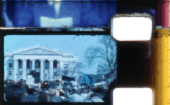Note to Pati, 1969
Something of an aesthetic convergence between the diaristic autobiographies and quotidian images of Jonas Mekas (as illustrated in his Diaries, Notes and Sketches chronicles) and the hand crafted dissonance and material violence of Stan Brakhage, Note to Pati presents a seemingly typical winter scene – the day after a snow storm as a suburban neighborhood digs out from under the accumulation and children make the most of an unexpected day off from school by playing in their winter wonderland. Saul Levine’s images are diffused, faded, and ephemeral, made all the more dissociating by Levine’s disorienting rapid cut editing, restless and twitching camerawork, and destabilized, quick pan sequences – an evocation of a transitory and wide-eyed innocence.
Note to Coleen, 1974
An encounter with a sidewalk portrait artist serves as the inspiration for Levine’s Note to Coleen, a whimsical, playful, and frenetic composition on duality and mirror images. Levine creates a curious sense of musicality through the intrinsic rhythm of the silent images. Presenting a rhythmic juxtaposition of quickly intercut, near subliminal replicating images capturing the posed subject (often of a seated woman) and the corresponding likeness captured by work-in-process sketch portrait, and edited through the visible vestigial materiality of the physical mechanical film splices (a recurring aesthetic in Levine’s cinema), the alternating images become an animated stasis, a stimulus of peripheral curiosity, a reflection of the iterative observation intrinsic in the process of creation.
New Left Note, 1968-1982
Saul Levine incisively distills the whirlwind of domestic protest, social revolution, and increasing public disillusionment over a protracted, bloody, and inextricable Vietnam War that defined the atmosphere of late 60s American culture in his magnum opus, New Left Note, a film inspired in part by his tenure as editor for – and complemented the ideals of – the progressive Students for a Democratic Society publication, New Left Notes. Levine juxtaposes seemingly irresolvable images of inertia and action, isolation and solidarity that reinforce his penchant for aesthetic hyperactivity – rapid intercutting, disorienting quick pans, and looping, reinforcing imagery – with sequences composed of visually longer takes and more stable, implicitly voyeuristic gaze that subvert the stasis of the images (and made all the more jarring in their discontinuity through the visibility of cement splices): initially, of an impromptu, distanciated metafilm (a soundless, low-resolution recording of Richard Nixon televised broadcast speech), then subsequently, an intimate, occasionally unfocused, and borderline transgressive image of the off-screen filmmaker and a resting young woman in varying stages of physical intimacy while traveling on a bus (perhaps returning from a protest march on Washington DC). In contrast to the adrenalized saturation of his autobiographical sketch, Note to … films, Levine’s images in New Left Notes reflect a more deliberate (and deliberative) approach to filmmaking as a tool for social change – a visceral chronicle of creative expression and cultural consciousness.
The Big Stick/An Old Reel, 1967-1973
On the surface, the introductory images of The Big Stick/An Old Reel seems uncharacteristic of a Saul Levine film, a whimsical, manipulated found film featuring a beat cop in seeming pursuit of Charlie Chaplin’s iconic tramp character, edited in matching continuity cuts such that the excerpted sequence unfolds in a seemingly infinite comic choreography of encounter and evasion, luckless fugitive and outwitted officer. Juxtaposed against (and at times, superimposed over) transitory images of real-life footage of a mass arrest and loading of prisoners into transport wagons for booking at police headquarters (the predictable repercussion for an act of protest or civil disobedience), serves as a subtle, but equally potent and critical complement to the overt politicization of New Left Note, a wry exposition on the duality of contemporary American society, not only with respect to the country’s polarization between passivity and activism – as well as an ingrained social stratification between privilege and exclusion – but also on the interminable vicious circle represented by the protracted and interminable conflict of the Vietnam War, a sobering commentary of the intrinsic farce reflected in the caricature of the faceless authority’s self-righteous and heavy-handed approach to dissent, opposition, and alterity.
Note to Poli, 1982-83
Continuing in the vein of the transgressive intimacy captured in New Left Note, Note to Poli in some ways anticipates Stephen Dwoskin’s expositions on fragility, ephemerality, and voyeurism (and in particular, in the transitory, almost dreamlike images Outside in). A daylight coupling seques to the seemingly disconnected image of a smoke-infused empty kitchen, perhaps invisibly connected by an unseen post-coitum ritual and time-occupying self-abstraction of a slowly inhaled cigarette, a visual study of emptiness and substance, stillness and turbulence, concentration and dissipation.
© Acquarello 2006. All rights reserved.
